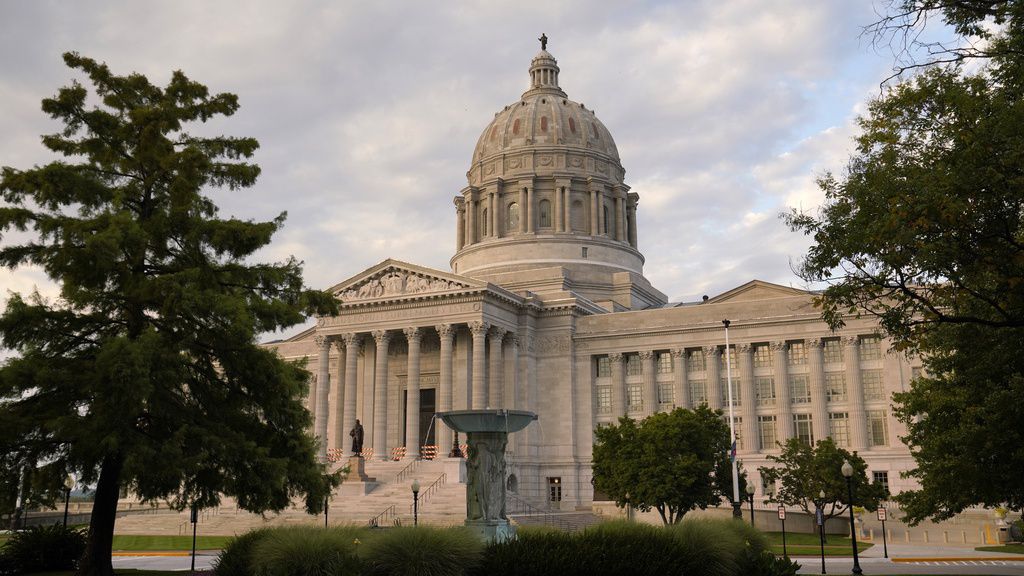Business
Column: More than just a store, 99 Cents Only gave a fair shake to all who entered
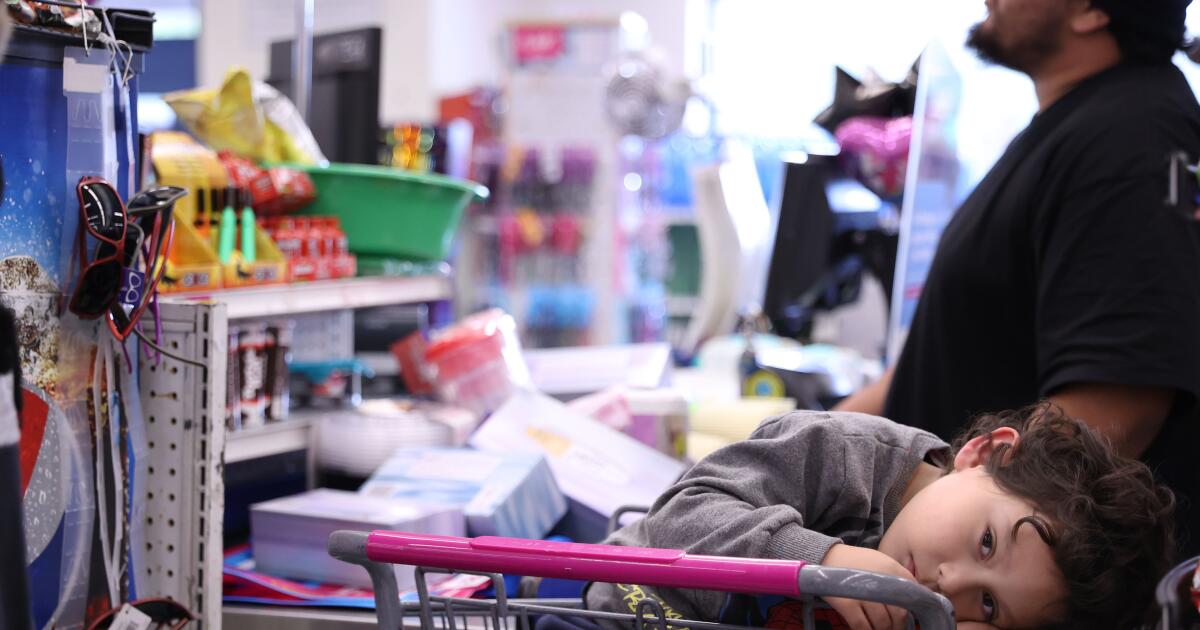
At 8:30 on Sunday morning, the parking lot at the 99 Cents Only store in Santa Ana was already beginning to fill. A few days earlier, the chain had announced it was closing all 371 of its stores in California, Nevada, Arizona and Texas.
This location off Main Street had seen better days. Unhoused people wandered near the trash bins. The walls and walkway leading to the front door were grimy. A massive window decal of fresh fruit near the entrance was peeling.
No one smiled while grabbing a shopping cart and walking in, even though all items were 10% off and signs screamed “Everything Must Go! Up to 30% Off.” Customers expressed their condolences to anyone with a name tag and vented to anyone who would listen.
“I blame [Gavin] Newsom,” said Rick Juarez, 53, referencing the California governor as he entered the store to stock up on batteries. He had shopped at this location for “at least” 20 years. “Too many taxes, too high the minimum wage. These companies just can’t compete, and so they have to close. And it’s poor people like us who end up suffering.”
Victor Barrios said he hopes the rumors of investors wanting to save the 99 Cents Only empire were true.
“This needs to stay open,” the 38-year-old delivery driver said. “I make OK money, and buying here helps me. But imagine if you’re on WIC? If you’re on Social Security? You need a place like this. Are people now supposed to go to Ralphs? Or Target? With what money?”
I can count on my hands the number of times I had previously shopped at 99 Cents Only, and maybe even on one hand — I’m more of a swap meet kind of guy. I’ve only gone with my wife, only to this location. But I had to visit out of respect — and sadness.
The 99 Cents Only Stores’ demise is another blow for the thrifters who make Southern California tick.
For generations, millions of us — immigrants, long-timers, working-class folks, or people who just want a good deal — have fueled an alternate economy far removed from fancy department and grocery stores. We patronize swap meets, Salvation Army stores, half-off warehouses and garage sales. Food comes from bartering with neighbors, or outlets like 99 Cents Only. My people inspired Carey McWilliams to half-jokingly call Los Angeles the “junkyard for a continent” in his 1946 masterpiece, “Southern California: An Island on the Land.”
Even today, as I make a good living and my wife runs her own restaurant, we live a penny-pinching life. A grocery splurge for us isn’t Whole Foods or Erewhon; it’s Trader Joe’s. I get my shirts and khakis at Marshalls or Ross Dress for Less, and guayaberas at the Anaheim Indoor Swap Meet or Olvera Street. The last time I spent more than $100 on an item of clothing was a black suit from Nordstrom for my mother’s funeral.
Those of us in this fellowship of frugality seek out bargains because we know that California’s booms inevitably end in bust. That’s what makes the imminent end of the 99 Cents Only empire — which started in Westchester in 1982 — so distressing.
Marta Lara, left, helps Anita Hernandez at a 99 Cents Only store in Los Angeles in 2008.
(Nick Ut / Associated Press)
Interim Chief Executive Mike Simoncic said in a statement that the chain was closing because of “significant and lasting challenges in the retail environment.”
Even though it was a multibillion-dollar company, 99 Cents Only operated under a premise straight from the Great Depression: a fair shake for everyone who entered. Here, the retiree shopped alongside the hipster, and the only colors that mattered were the bright blue and pink on the marquee of each store. The chain had locations in blue-collar towns such as Santa Ana and Colton, but also suburbs such as Alhambra and Santa Monica.
Yes, off-brands and remaindered products made up the bulk of offerings, but treasures awaited for those who regularly came. One day, you’d get a generic brand of sriracha, another time, regular Tapatío hot sauce at prices you last saw during your childhood. And who knew when you might encounter a small blowup doll of AC/DC frontman Angus Young, like I did on Sunday?
There was a camaraderie among fans that rivals such as Dollar Tree or Dollar General or even Walmart were never able to match. Founder Dave Gold was a SoCal business iconoclast on the level of In-N-Out founder Harry Snyder and cafeteria magnate Clifford Clifton, who made sure that the least among us could eat and shop like kings.
Nowadays, discount shopping is just an Amazon click away — a race to the bottom of inferior products and loneliness.
“I could buy toys for my younger kids, my older kids could get pens for school, and I could do groceries for all of us,” Altagracia Nuñez told me in Spanish as she perused the beauty aisle, where sticks of men’s and women’s deodorant looked like tumbled dominoes. “And the prices, of course.”
She stayed quiet, then offered a weak laugh. “Well, everything is more expensive nowadays, so I guess this had to end.”
Friends told me that their local 99 Cents Only stores were beginning to look as bereft as the pandemic days. But the Santa Ana branch I visited was well stocked. It was interesting to see what was available and what wasn’t.
The shelves that once held reusable containers were empty, but the Easter decorations hadn’t moved. There were no more bleach bottles by LA’s Totally Awesome, but the rest of the brand’s cleaning products were available. Milk was sold out, but stacks of bland El Comal corn and flour tortillas — already marked 50% off — were barely touched.
Everyone’s shopping cart seemed fuller than usual, and they all seemed to have at least one package of both toilet paper and cleaning towels. I didn’t need either, or anything, really. So I bought an array of canned goods from a bygone era — Hormel canned tamales, Armour potted meat, Libby’s chicken Vienna sausages and pork luncheon meat, whatever on Earth that is — to mark the end of another Southern California classic.
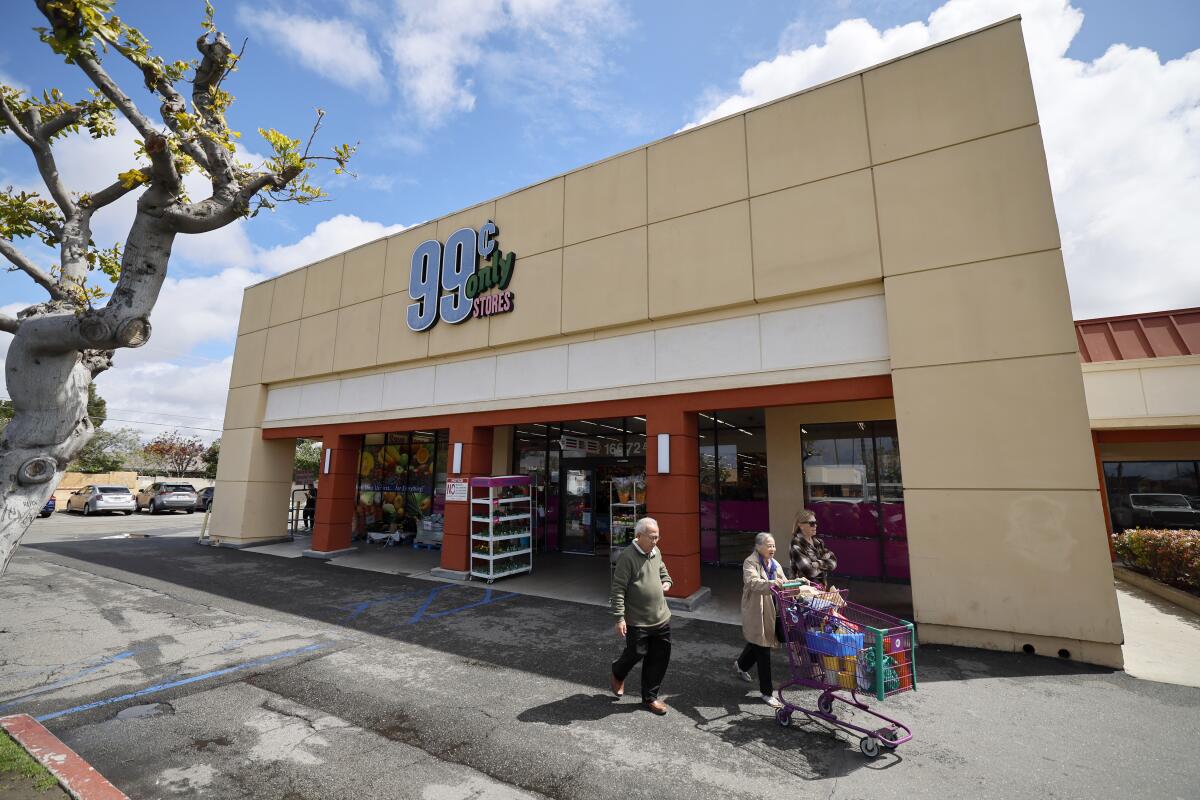
Shoppers exit the 99 Cents Only store in Huntington Beach
(Allen J. Schaben / Los Angeles Times)
The Frito-Lay and Takis displays near the checkout counter were picked clean, as was the Pepsi cooler. Cheery new jack swing tunes played on invisible speakers. Behind me, a man softly sang to himself “Se va, se va la 99” (“It’s going, the 99 is going”). In front of me, a woman announced in Spanish to no one in particular, “I think I’ll come back here another time.”
“We close June 3,” the cashier responded. “Come back.”
He let a beat pass. “Come here until we’re done.”

Business
Sony warns tech companies: Don't use our music to train your AI
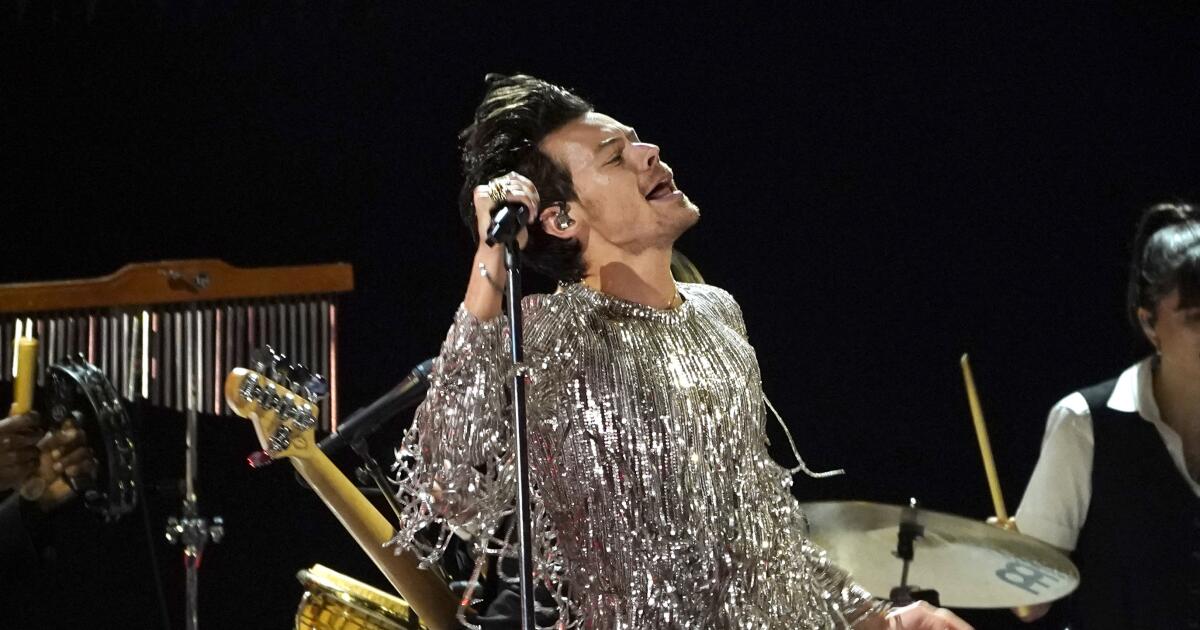
Sony Music Group is sending letters to 700 artificial intelligence developers and music streaming services warning them to not use its artists’ music to train generative AI tools without its permission.
The company — one of the three largest recorded music firms — said it is explicitly opting out of the use of its music for training or developing AI models through text or data mining or web scraping as it relates to lyrics, audio recordings, artwork, musical compositions and images. Sony Music Group artists include Celine Dion, Doja Cat and Harry Styles.
“We support artists and songwriters taking the lead in embracing new technologies in support of their art,” Sony Music Group said in a statement on its website Thursday. “Evolutions in technology have frequently shifted the course of creative industries. … However, that innovation must ensure that songwriters’ and recording artists’ rights, including copyrights, are respected.”
The letters were sent to companies including San Francisco-based ChatGPT creator OpenAI and Mountain View-based search giant Google, according to a person familiar with the matter who was not authorized to speak publicly. OpenAI and Google did not immediately respond to requests for comment.
The move comes as the entertainment industry is grappling with rapid innovations in artificial intelligence technology. Writers and actors raised concerns last summer about whether leaving AI unchecked could threaten their livelihoods. Meanwhile, some creatives have marveled at the advancements that could allow them to pursue bold ideas with tight budgets.
This year, OpenAI unveiled its text-to-video tool Sora, which was used to create a four-minute music video for music artist Washed Out. The director of the video told The Times that Sora helped him depict multiple locations and visual effects that he otherwise couldn’t have.
But AI can also create chaos. Celebrities have dealt with “deep fakes” — false videos or audio depicting a celebrity endorsing certain brands or activities. To help protect their clients against unauthorized use of their voice and likeness, Century City-based Creative Artists Agency is helping talent create their own digital doubles.
On Thursday, two New York voice-over actors sued Berkeley-based AI voice generator business Lovo for unauthorized use of their voices. Lovo did not immediately return a request for comment. The lawsuit was filed in U.S. District Court for the Southern District of New York.
Some people in the entertainment industry have said they would like the AI companies to be more transparent about how they are training their tools and whether they have the appropriate copyright permissions.
OpenAI has said its large language models, including those that power ChatGPT, are developed through information available publicly on the internet, material acquired through licenses with third parties and information its users and “human trainers” provide.
The company said in a blog post that it believes training AI models on publicly available materials on the internet is “fair use.”
But some media outlets, including the New York Times, have sued OpenAI. The newspaper raised alarms about how its stories are being used by the tech company.
In Sony Music Group’s letters to AI businesses, the company said it has reason to believe its content may have been used to train, develop or commercialize artificial intelligence systems without its permission, according to a copy obtained by the Times. Sony Music Group asked the tech companies to provide information regarding that use and why it was necessary.
Sony Music Group, owned by Tokyo-based electronics giant Sony Corp., also wants music streaming providers to add language in its terms of service saying that third parties are not allowed to mine and train using Sony Music Group content, the person familiar with the matter said.
Business
A woman was dragged by a self-driving Cruise taxi in San Francisco. The company is paying her millions

General Motors’ autonomous car company, Cruise, has reportedly agreed to pay an $8-million to $12-million settlement to a woman who was hospitalized after getting dragged along the pavement by a self-driving taxi in San Francisco last year.
The woman, a pedestrian, was struck by a hit-and-run vehicle at 5th and Market streets and thrown into the path of Cruise’s self-driving car, which pinned her underneath, according to Cruise and authorities. The car dragged her about 20 feet as it tried to pull out of the roadway before coming to a stop.
She sustained “multiple traumatic injuries” and was treated at the scene before being hospitalized.
It’s unclear when the settlement was reached or the exact amount, sources familiar with the situation told Fortune and Bloomberg. The condition of the woman, whose name was not released by authorities, is unknown, but a representative of Zuckerberg San Francisco General Hospital told Fortune that she had been discharged.
Cruise initially said that its self-driving car “braked aggressively to minimize impact” but later said the vehicle’s software made a mistake in registering where it hit the woman. The car tried to pull over but continued driving 7 mph for 20 feet with the woman still under the vehicle.
“The hearts of all Cruise employees continue to be with the pedestrian, and we hope for her continued recovery,” Cruise said in a statement.
Cruise halted its driverless operations after its autonomous taxi license was suspended by California’s Department of Motor Vehicles. The company was also accused of lying to investigators and withholding footage of the car crash.
Cruise said this week that it would start testing robotaxis in Arizona with a “safety driver” behind the wheel in case a human needs to take control of the vehicle, according to a company news release.
“Safety is the defining principle for everything we do and continues to guide our progress towards resuming driverless operations,” according to the release.
Business
How YouTube became must-see TV: Shorts, sports and Coachella livestreams
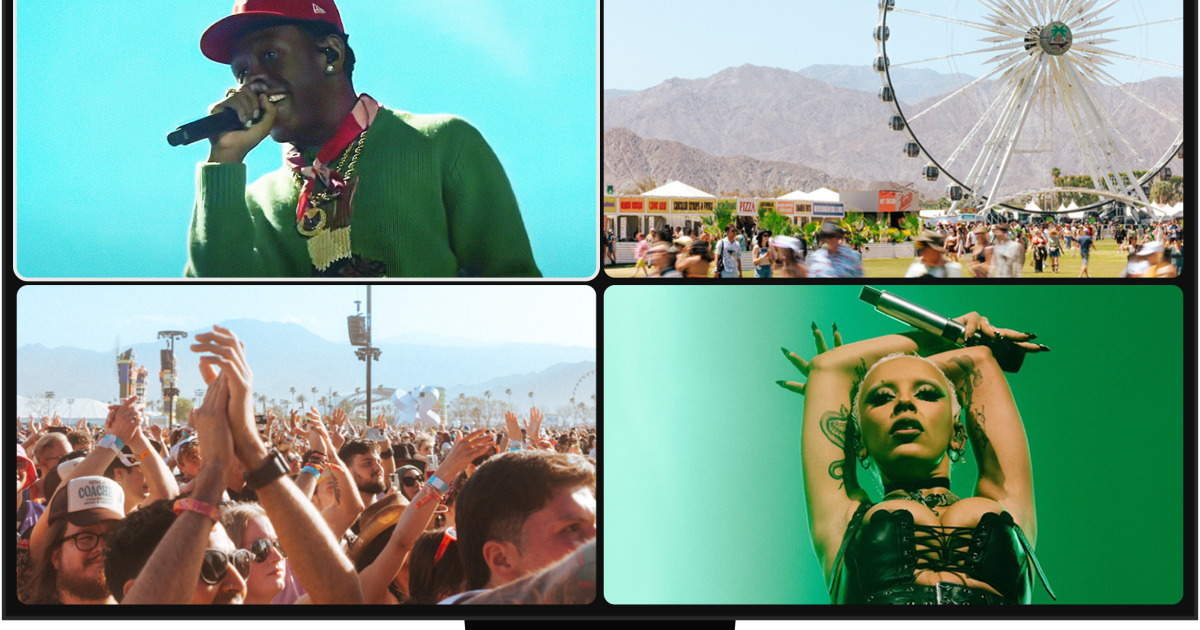
When YouTube launched nearly two decades ago, its first clip was a grainy video of co-founder Jawed Karim speaking to the camera while standing in front of the elephants at the San Diego Zoo.
Not exactly must-see TV.
Since, then the online video giant has increasingly been the entertainment of choice for billions of people. And while the Google-owned service is still often thought of as being the destination for people watching funny short videos on their smartphones, the way that Americans watch it has changed in a big way.
People are increasingly choosing to watch YouTube on their connected TVs rather than on laptops and mobile devices, treating it more and more like a regular television destination.
The San Bruno, Calif.-based video giant said more than 150 million people in the U.S. are watching YouTube on connected TV screens every month, citing December 2022 data. That’s up 11% from 2021. YouTube is consistently the most watched streaming service in the U.S. on a TV in the U.S. every month, even beating Netflix and Amazon’s Prime Video since February 2023, according to Nielsen. The service accounts for nearly 10% of television viewing, the data firm said.
According to research firm Emarketer, U.S. adults spend 36 minutes each day watching YouTube, with 17 of those minutes on a connected TV, four minutes on a desktop or laptop computer and 15 minutes on a mobile device.
A variety of content is driving the company’s evolution. YouTube said TVs accounted for more than 50% of the watch time for its Coachella livestream this year, which is higher than ever before. Views of Shorts, clips that are 60 seconds or less, on connected TVs more than doubled last year, YouTube said.
“We’ve invested in making sure that YouTube really captures the totality of the experience that people want,” said Christian Oestlien, YouTube’s vice president of product management for connected TV. “What we hear from our users is they want to be able to watch their favorite creators but also highlights from their favorite sporting events, listen to their favorite artist and watch their favorite podcast and do it all in this one contained experience.”
At a time when consumers are choosing between multiple streaming services, YouTube has an advantage of having a wide variety of options, from live sports to user-generated videos. The company said the increase in TV watch time comes as connected TVs are becoming more widely available.
TV screen time can be helpful to streamers wishing to court more advertising dollars. This week, television networks and streaming services Amazon and Netflix made gala presentations to advertisers, showing off the programming they have coming up.
YouTube on Wednesday presented to advertisers new features such as branded QR codes and non-skippable assets on connected TVs.
“YouTube is wanting to position themselves not just as a digital advertising option, they want advertisers to see them on the same advertising footing as any other streaming service,” said Brett Sappington, founder of Dallas-based media and insights firm Sappington Media.
YouTube has introduced features to improve the television viewing experience, including the option to watch Coachella performances through a four-way split screen. The company also has shopping options.
“This isn’t my dad’s TV or my grandma’s TV,” Oestlien said. “This is TV rethought for a new generation.”
YouTube video creators have also embraced TV viewing, Oestlien said. In the last three years, the number of top YouTube creators who receive most of their watch time from TV screens has quintupled, YouTube said.
YouTube has also gotten a boost from its deal to become the home of pro football’s “NFL Sunday Ticket” game package. Fans will watch live games on YouTube on Sunday, then come back and watch clips through its video library or commentary from its creators, Oestlien said.
“It really becomes this surround-sound experience where, as a football fan, you can come to YouTube any day of the week,” he said.
YouTube and other streaming services have been competing for sports league rights in order to increase viewership. Amazon has the NFL’s “Thursday Night Football” games and has bid for a package of NBA matches. On Wednesday, Netflix announced it had secured two Christmas NFL games for 2024.
-

 Politics1 week ago
Politics1 week agoBiden takes role as bystander on border and campus protests, surrenders the bully pulpit
-

 Politics1 week ago
Politics1 week ago'You need to stop': Gov. Noem lashes out during heated interview over book anecdote about killing dog
-

 Politics1 week ago
Politics1 week agoRFK Jr said a worm ate part of his brain and died in his head
-

 News1 week ago
News1 week agoMan, 75, confesses to killing wife in hospital because he couldn’t afford her care, court documents say
-

 World1 week ago
World1 week agoPentagon chief confirms US pause on weapons shipment to Israel
-

 Politics1 week ago
Politics1 week agoHere's what GOP rebels want from Johnson amid threats to oust him from speakership
-

 World1 week ago
World1 week agoPro-Palestine protests: How some universities reached deals with students
-

 World1 week ago
World1 week agoConvicted MEP's expense claims must be published: EU court


